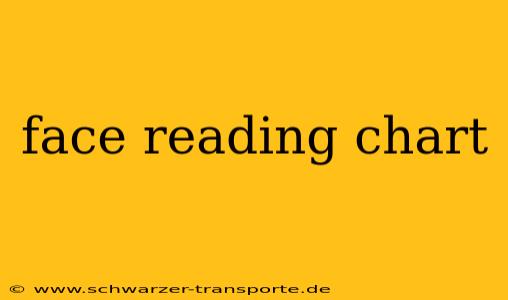Meta Description: Unlock the secrets of face reading! This comprehensive guide provides a detailed face reading chart, explaining features and their meanings. Learn about personality traits, health, and more through facial analysis. Discover the art of physiognomy and improve your people skills. Uncover hidden insights with our illustrated guide!
Introduction to Face Reading (Physiognomy)
Face reading, also known as physiognomy, is the ancient art of assessing a person's character, personality, and even potential health based on their facial features. While not a definitive science, it offers a fascinating framework for understanding people better. This detailed face reading chart will guide you through the key areas to observe. Remember, this is for entertainment and self-discovery; it shouldn't be used for making critical judgments.
Understanding the Basic Principles
Before we dive into the chart, let's establish some fundamental principles:
- Holistic Approach: Face reading isn't about analyzing single features in isolation. It's about considering the overall harmony and balance of the face.
- Subjectivity: Interpretations can be subjective. Different schools of thought exist within face reading. Use this chart as a starting point for your own observations.
- Practice Makes Perfect: The more you practice, the better you'll become at discerning subtle nuances and integrating your observations.
The Face Reading Chart: A Detailed Guide
This section breaks down the face into key zones and features, explaining common interpretations. Remember that these are general guidelines, and individual variations exist.
1. The Forehead:
- High and Broad Forehead: Often associated with intelligence, ambition, and foresight.
- Low and Narrow Forehead: May suggest a more practical and less intellectual approach to life.
- Wrinkles: Vertical wrinkles might indicate worry or stress; horizontal wrinkles can suggest concentration or thoughtfulness. (Image of forehead wrinkles with annotations)
2. The Eyes:
- Eye Shape & Size: Large eyes might signify creativity and sensitivity; small eyes could indicate focus and observation. (Image of different eye shapes)
- Eye Color: While interpretations vary, some associate certain colors with specific traits. (Image illustrating different eye colors)
- Eye Distance: Close-set eyes might suggest a cautious nature; wide-set eyes, a broad perspective.
3. The Nose:
- Nose Shape: A long, straight nose is sometimes linked to determination; a shorter, broader nose to sociability. (Image of different nose shapes)
- Nose Bridge: A high bridge might be associated with confidence; a low bridge with sensitivity.
4. The Mouth & Lips:
- Mouth Size & Shape: A wide mouth is often linked to expressiveness and outgoingness; a smaller mouth, to more reserved personalities. (Image of different mouth shapes)
- Lip Fullness: Full lips can suggest sensuality and empathy; thinner lips, a more reserved or analytical nature.
5. The Chin:
- Strong & Prominent Chin: Often associated with determination, willpower, and leadership qualities.
- Weak or Receding Chin: May suggest a more passive or less assertive personality. (Image illustrating different chin shapes)
6. The Jawline:
- Square Jawline: Can be associated with strength, determination, and a direct approach.
- Rounded Jawline: Might suggest a gentler, more adaptable personality. (Image of different jawlines)
7. The Ears:
- Earlobe Size and Shape: Large earlobes are sometimes associated with good fortune or prosperity. (Image showcasing different earlobe types)
8. The Overall Facial Balance
A harmonious balance between features suggests inner peace and balance. Disproportionate features could indicate areas of conflict or imbalance within the individual.
Beyond the Basics: Advanced Face Reading Considerations
- Skin Tone and Texture: Observe the skin's overall health and complexion.
- Facial Expressions: A person's habitual expressions offer valuable insights into their emotional landscape.
- Mole Placement: Certain mole locations are linked to specific characteristics in some traditions. (Image with labeled mole placement)
Frequently Asked Questions (FAQs)
Q: Is face reading accurate?
A: Face reading is not a scientifically proven method. Its accuracy is subjective and should be interpreted with caution.
Q: Can face reading predict the future?
A: No, face reading primarily focuses on character and personality traits, not future events.
Q: How can I improve my face reading skills?
A: Practice regularly, study different faces, and compare your observations with established resources and other practitioners.
Conclusion: Embracing the Art of Face Reading
Face reading is a fascinating tool for self-discovery and improving interpersonal skills. By understanding the basic principles and using this comprehensive chart as a guide, you can begin to decipher the subtle clues hidden within a person's facial features. Remember to approach face reading with an open mind and respect for individual differences. This ancient art offers a unique perspective on human nature, but should not be used to make judgments. Continue practicing, and you may surprise yourself at what you can learn!
